Introduction & Analysis
This collection of open-source English-language news articles published over the past week highlights significant events and issues concerning Myanmar. They present a snapshot of the country's safety and security landscape.
News during this reporting period is dominated by the March 28, 2025, earthquake and its aftermath.
The security situation in earthquake-devastated Myanmar is severely compromised due to the combined effects of the natural disaster and the ongoing civil conflict, where the military junta has continued its operations and rejected ceasefire proposals intended for aid delivery. The earthquake itself has resulted in widespread destruction, making areas unsafe due to collapsed buildings and damaged infrastructure, and rescue and aid efforts are further impeded by the military's restrictions on access for journalists and aid workers, as well as concerns about the potential weaponization and obstruction of humanitarian assistance. Furthermore, reports of continued military airstrikes in earthquake-affected regions and even an incident of firing on a Chinese Red Cross aid convoy highlight the volatile and insecure environment for both survivors and those attempting to provide help.
Conflict
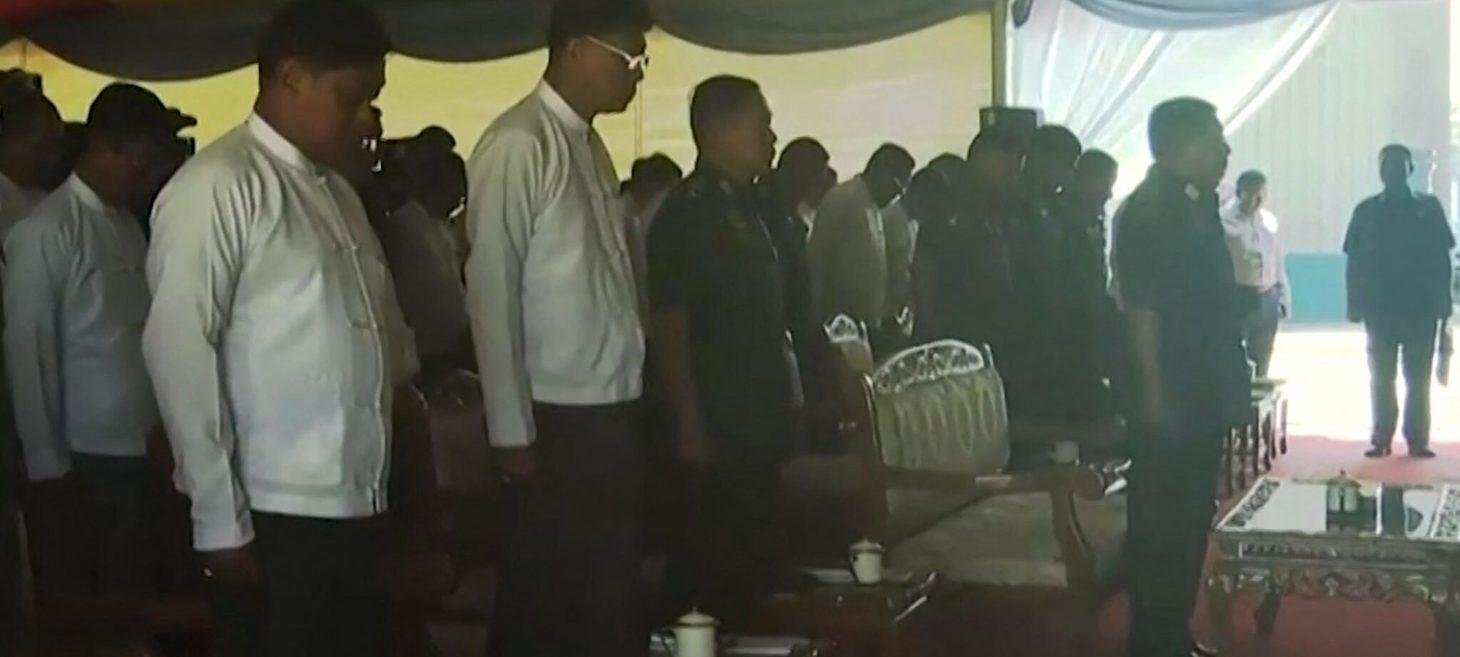
Junta rejects quake ceasefire, death toll hits 2,791
Following a devastating earthquake in Myanmar where the death toll has reached 2,719 with 400 missing and over 4,000 injured, the ruling junta, led by Senior General Min Aung Hlaing, has rejected ceasefire proposals from ethnic armed organizations (EAOs) and the National Unity Government (NUG) aimed at enabling crucial earthquake relief. Despite a pause in EAO attacks after the earthquake, Min Aung Hlaing accused these groups of using the opportunity to regroup and train, asserting that military operations would continue as a form of defense. This rejection of a ceasefire underscores the ongoing conflict across the country, with the military continuing its offensives, including airstrikes and shelling in regions like Shan State, Sagaing, Kachin State, Karenni State, and Rakhine State, even as the nation grapples with the earthquake's destruction.
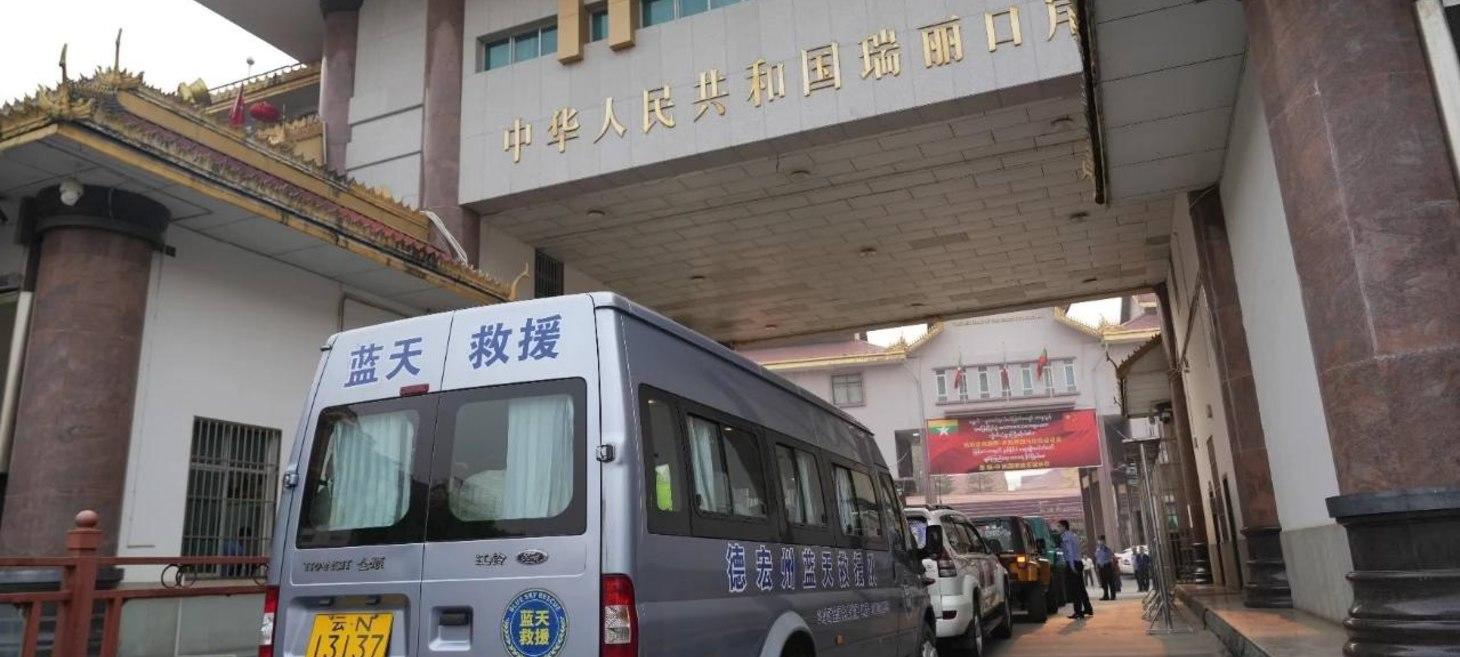
Myanmar junta admits to firing on Chinese Red Cross aid convoy
The Myanmar military junta confirmed that its troops fired warning shots at a nine-vehicle Chinese Red Cross aid convoy carrying essential supplies for earthquake victims in Mandalay and other affected areas. The incident took place around 9:30 pm in northern Shan State’s Nawnghkio Township, near Ohn Ma Thee, an area under the control of the Ta’ang National Liberation Army (TNLA) and an active conflict zone. According to the junta spokesperson, the convoy was fired upon from a distance of 100-200 meters after it allegedly failed to stop at a security checkpoint, and the vehicles subsequently fled back towards Nawnghkio. The junta noted that the trucks had Myanmar license plates and did not have prior approval, and an investigation into the incident will be launched. The TNLA corroborated the incident, stating that the relief trucks returned to Nawnghkio under their protection following the attack, which occurred after a devastating earthquake that claimed over 3,000 lives and prompted calls for a halt to fighting from the Brotherhood Alliance.
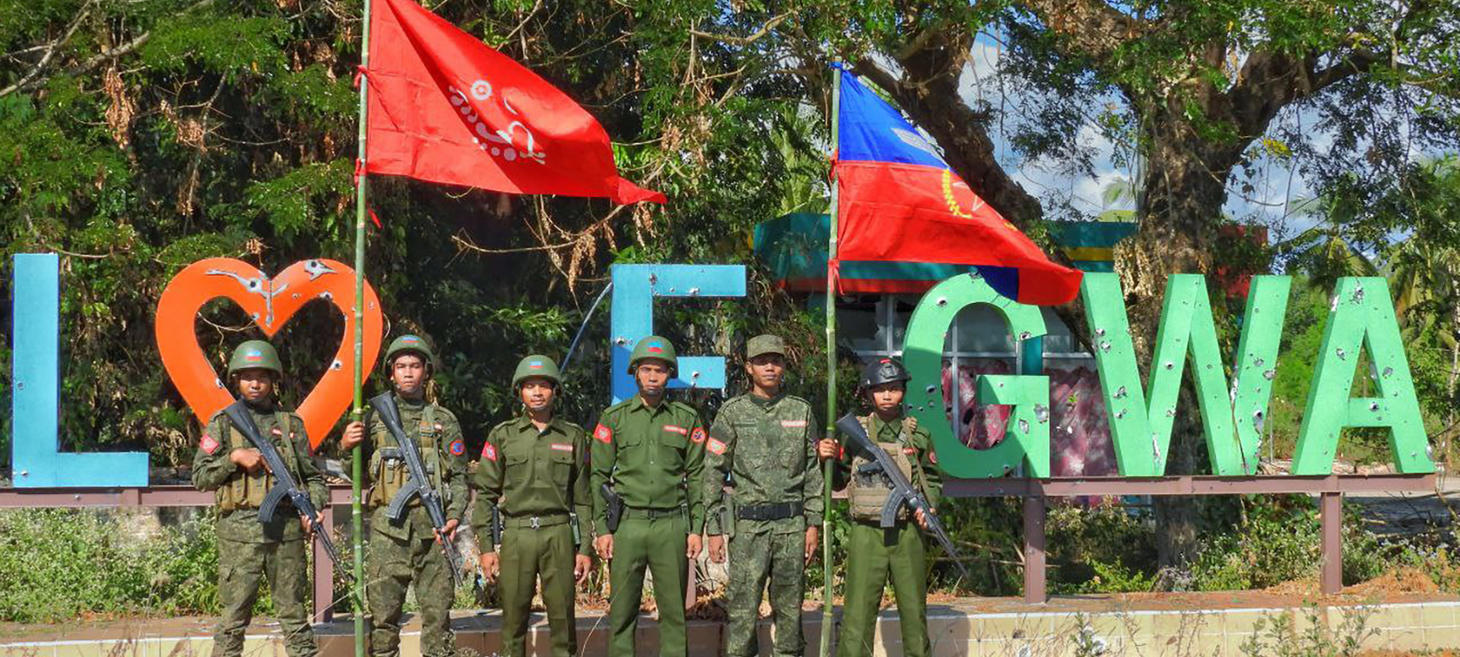
AA and Allied Local Resistance Seize Ayeyarwady Villages
Combined forces of the ethnic Arakan Army (AA) and regional People’s Defense Forces (PDFs) have reportedly seized several villages in Ayeyarwady’s Lemyethna Township following fierce clashes last week. These clashes, which included air raids, occurred in the eastern foothills of the Arakan Mountains that separate Lemyethna from Gwa Township after junta troops raided the area in response to reports of AA troops crossing the mountains. The fighting led to the fall of Tonetaw village to the combined resistance forces on Tuesday and the reported defeat of regime deployments in other villages, resulting in more than 1,000 people fleeing their homes, with some remaining trapped, and reports of many bodies in Tonetaw, including both regime soldiers and PDFs; junta battalions in nearby Yegyi and Ingapu townships provided artillery support during the fighting, but despite advancements, the rebel forces still face a daunting task reaching Lemyethna town on the eastern bank of the Ngawun River and crossing the Pathein-Monywa Highway. The AA has been advancing on Ayeyarwady since capturing Gwa Township, with fighting also occurring in other townships, and analysts believe the conflict zone is likely to expand.

Aftershocks rattle earthquake-devastated Myanmar as military bombs rebel areas
A powerful 7.7-magnitude earthquake devastated Myanmar, with Mandalay as the epicenter, resulting in at least 1,600 confirmed deaths and a likely higher toll. This disaster struck a nation already enduring a brutal four-year civil war and facing a severe humanitarian crisis. Despite the catastrophic earthquake that has incapacitated essential services and rendered roads impassable, Myanmar’s ruling military junta has continued to drop bombs in rebel areas. This ongoing military action occurs even as the National Unity Government (NUG), the government in exile, announced a two-week pause in offensive military operations in affected areas. The continued bombing by the junta exacerbates the crisis and raises concerns about the delivery of aid, which is already hampered by buckled roads, debris, and telecommunications disruptions. The U.N. has highlighted the urgent need for food, clothing, shelter, and medical supplies as hospitals are overwhelmed. While some international aid is arriving, the ongoing military actions further compound the suffering in the earthquake-devastated nation.
Conscription

Military-Appointed Village Heads in Ywangan Accused of Arbitrary Conscription
Military-appointed village heads in Ywangan Township, Southern Shan State, are accused of arbitrary conscription, reportedly selecting individuals based on personal bias and opposition to the military, rather than a fair lottery or registered list, and disproportionately targeting those with whom they have conflicts and individuals from lower-income backgrounds. These officials have allegedly submitted lists of selected individuals to the military council and have threatened villagers with conscription quotas. Contrary to previous announcements, reports indicate that men older than 35 are now being forcibly conscripted, causing fear and uncertainty among residents, with concerns raised about the well-being of those already taken. This situation is compounded by a tightened military presence in Ywangan, including increased security checkpoints and troop deployments, leaving residents feeling they have no choice but to comply with the conscription.
Economy
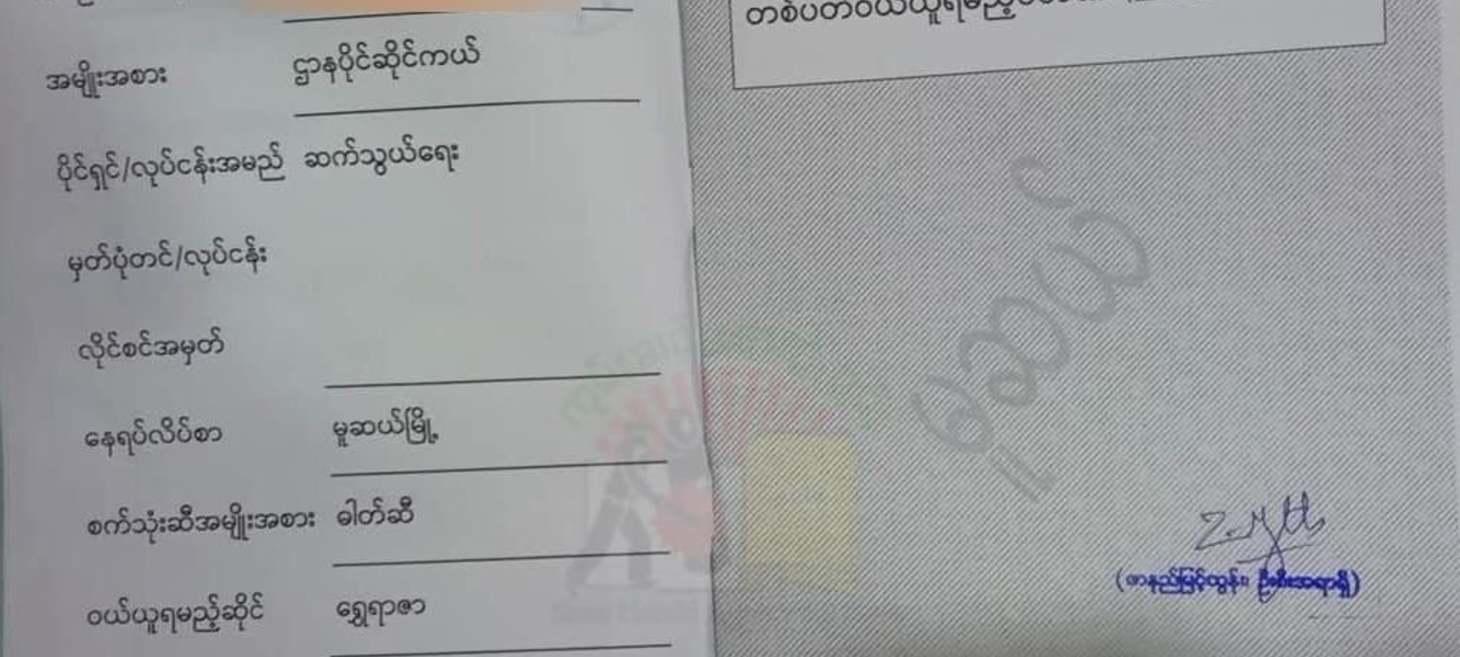
Military Council’s Fuel Rationing Sparks Shortages and Price Hikes in Muse
The Myanmar military council's imposition of strict fuel rationing in Muse Township, Northern Shan State, starting around March 24, 2025, has led to severe shortages and significant price increases, severely impacting local businesses and disrupting crucial cross-border trade with China. Private vehicle owners are limited to a meager four gallons of fuel per month with a permit system, forcing many to seek alternatives as military-controlled stations operate only two days a week and sell petrol at 5,200 Kyats per liter, while private sellers charge up to 7,000 Kyats, fostering a black market. Furthermore, fuel shipments from Mandalay are blocked at Namkham, driving prices even higher outside Muse (6,500–8,000 Kyats per liter), leading desperate residents to illegally purchase and resell fuel from China. This fuel crisis in Muse, a vital trade hub, raises fears of paralyzed transportation and a deepening economic downturn in the region, echoing earlier fuel permit requirements for businesses in Kyaukme since December 2024.
Ethnic Issues
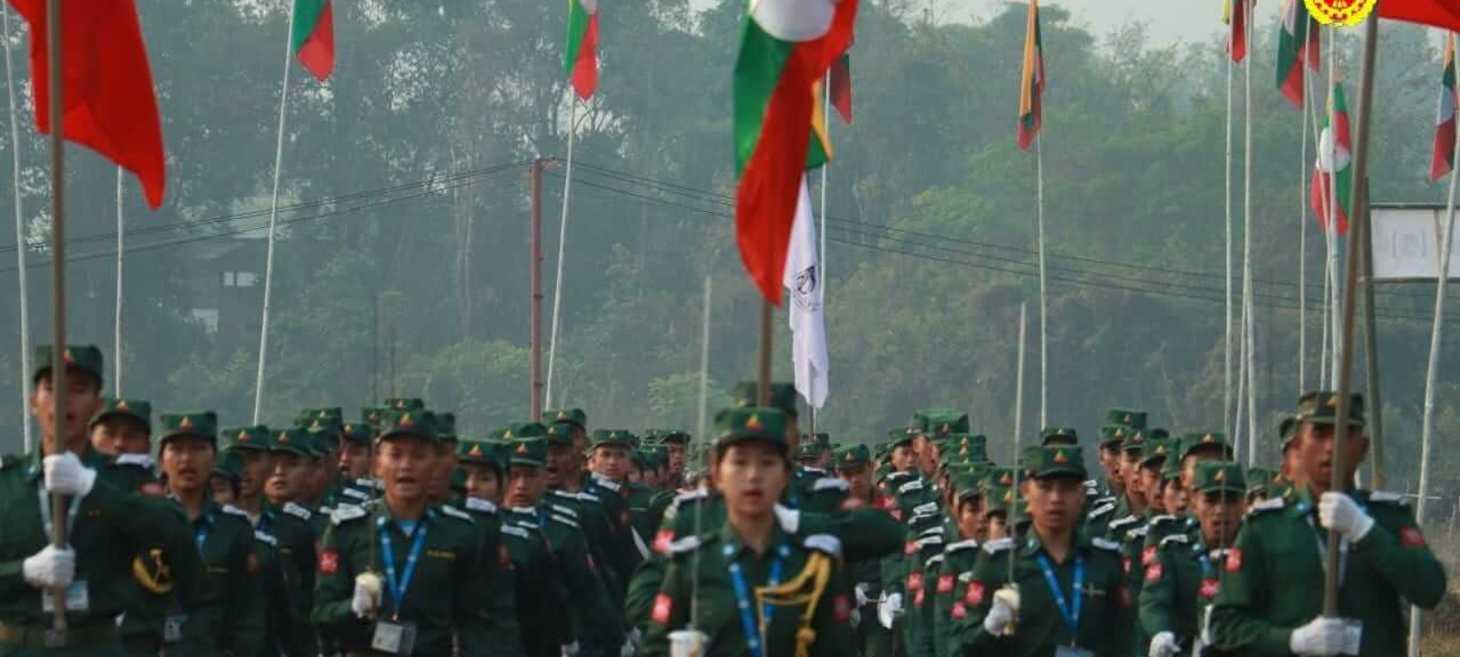
SSPP-TNLA ROW : TNLA flexes its military muscles
The Ta’ang National Liberation Army (TNLA) has been actively expanding its military influence in northern Shan State, leading to tensions and conflicts with other armed groups such as the Shan State Progress Party (SSPP) and the Kachin Independence Organization/Army (KIO/KIA). The TNLA has reportedly engaged in military operations to push out the SSPP from areas like Möng Mit Township, resulting in armed confrontations and exchanges of protest letters. Additionally, the TNLA has seized KIA liaison offices and expelled KIA soldiers, leading to worries about potential clashes. Despite these expansions, the TNLA has faced setbacks due to Myanmar junta offensives utilizing advanced drones and heavy artillery, causing them to lose control of areas like Taunghkam. The TNLA's approach has been criticized for its "might is right" mentality, territorial expansionism, and promotion of narrow ethno-nationalism, including forced recruitment and disregard for local populations and existing ethnic armed organizations. Some suggest the TNLA should reconsider its approach and pursue its goals through political dialogue instead of military expansion.
Healthcare
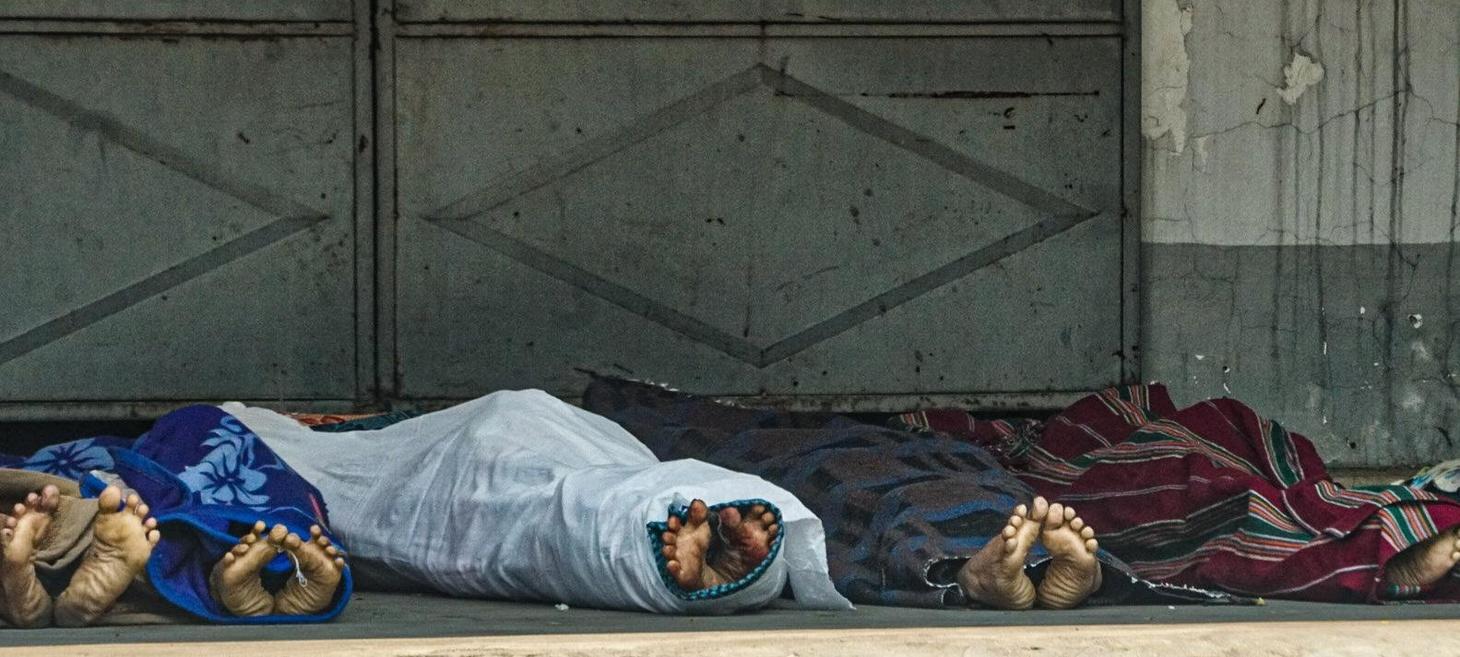
Myanmar’s hospitals, already under strain from regime, struggle to cope with quake’s aftermath
Myanmar's healthcare system, already struggling under four years of military rule and the persecution of medical professionals opposed to the regime, has been severely strained by a recent earthquake near Mandalay. Hospitals in major urban areas like Mandalay and Naypyitaw are overwhelmed with a high influx of patients and lack sufficient space and supplies. Prior to the earthquake, the military regime had forcibly closed healthcare facilities and revoked licenses of private hospitals in Mandalay, further diminishing healthcare capacity. The earthquake caused chaos in remaining hospitals like Mandalay General Hospital, with patients lying on the ground, and resulted in significant damage or destruction to numerous public and private hospitals in Naypyitaw. This has led to patients being treated outdoors and urgent calls for blood and medical supplies, making the situation even more dire than the COVID-19 pandemic due to the weakened state of the healthcare system.
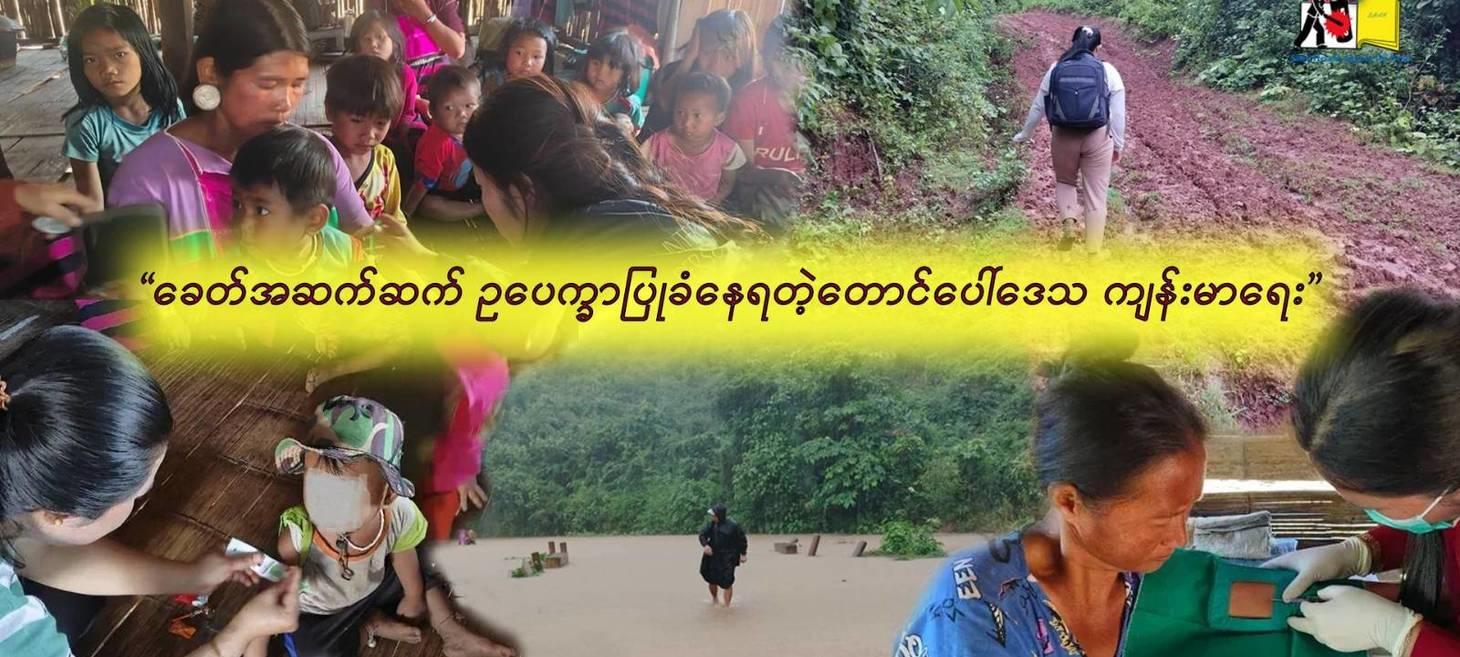
Healthcare Neglected in Shan State Highlands
Healthcare in the Shan State highlands is significantly neglected, leaving ethnic minorities without adequate access due to remote locations, poor transport links, and insufficient healthcare funding. Nurse Ma Nang Mway highlights the extreme difficulties, especially during the rainy season when unmade roads become impassable, forcing her to walk for hours to reach patients in areas around Kunhing Township. The situation has worsened since the 2021 military coup, with a decline in Myanmar's healthcare sector exacerbating existing challenges. Rural healthcare centers in areas like Kar Li Town and Mongnawng Town are often unused due to a lack of staff, and some Ethnic Armed Organizations (EAOs) obstruct health education, including contraception. Additionally, increased natural resource extraction, particularly coal mining, has led to environmental damage and a rise in health problems like skin disease. Consequently, the healthcare system in these regions is failing, leaving communities to be self-reliant.
Humanitarian
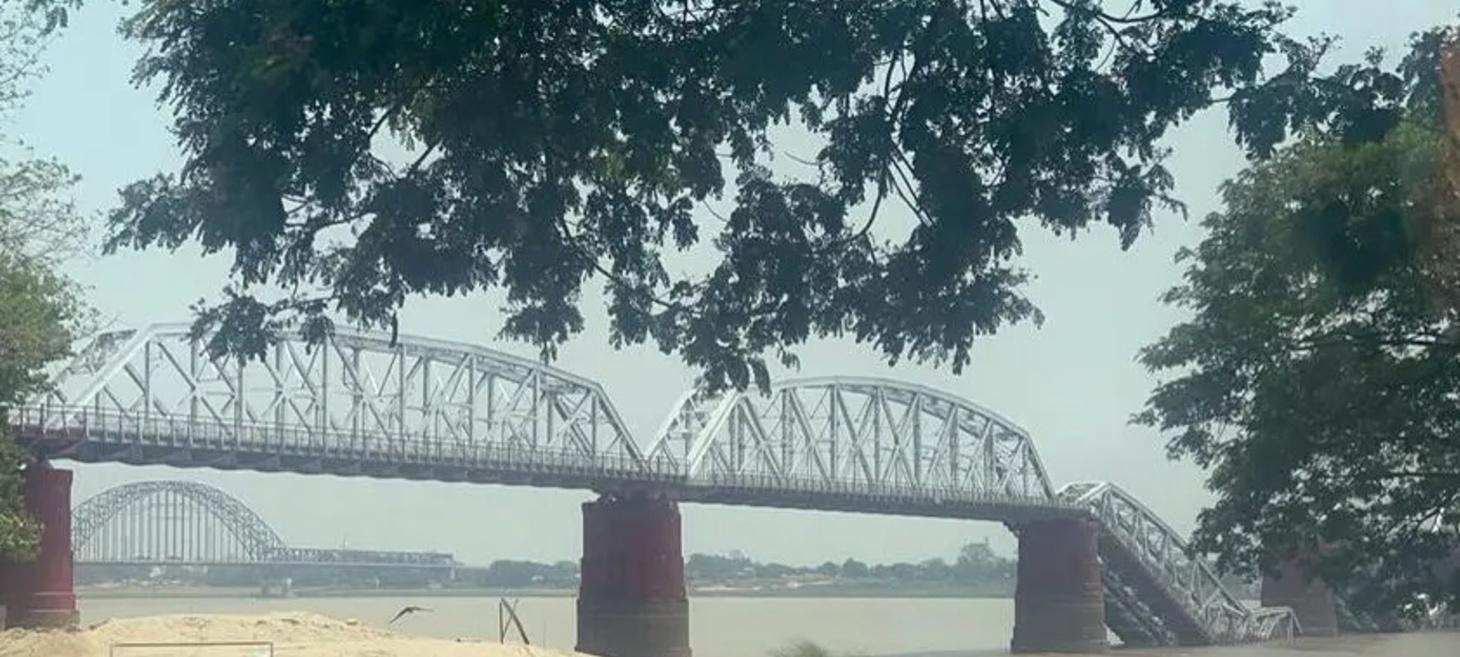
Myanmar Quake Death Toll Tops 2,000 as Help Comes Slowly for War-Torn City
A devastating 7.7-magnitude earthquake struck the war-torn city of Sagaing, Myanmar, on March 28, 2025, becoming the country's worst in over a century. The quake caused widespread destruction, razing monasteries and apartment buildings and cutting off the city's 300,000 residents due to damaged roads and a collapsed bridge. The death toll had reached 2,056 by late Monday, with 3,900 injured, and preliminary estimates suggested it could exceed 10,000. Despite the dire situation and a rare call for international aid by the military junta, relief efforts were severely hampered by military checkpoints, restrictions on local volunteers and doctors from the Civil Disobedience Movement, and the closure of key transportation routes. While some international aid groups and a Malaysian trauma team managed to enter Sagaing, countless aid trucks were delayed, and residents faced shortages of food, water, and shelter, highlighting the city's isolation exacerbated by the ongoing civil war and internet blackout.
Military
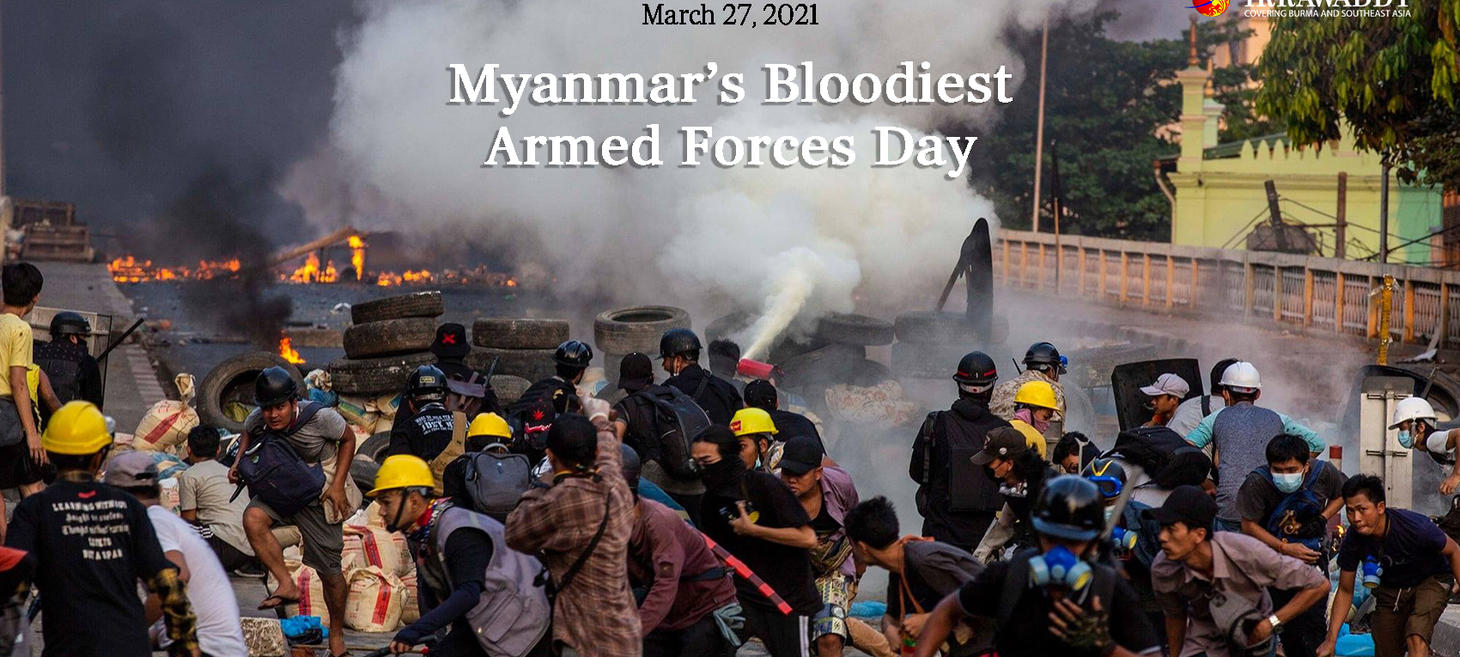
Myanmar’s Bloodiest Armed Forces Day
On March 27, 2021, which was also the military's Armed Forces Day, Myanmar's military junta, led by Min Aung Hlaing, carried out a brutal crackdown on civilians protesting the February 1 coup, resulting in over 100 fatalities across the country in regions and states including Yangon, Mandalay, Bago, Ayeyarwady, Shan, and Mon. This marked the bloodiest day of the junta's suppression of peaceful demonstrations, where soldiers used tear gas and live ammunition despite initially claiming to have only used rubber bullets and targeted protesters in the head. During his Armed Forces Day address, Min Aung Hlaing threatened protesters, labeling them as rioters and referencing the military's strength in suppressing ethnic insurgencies. While most Western diplomats shunned the Armed Forces Day event, Deputy Russian Defence Minister Colonel General Alexander Vasilyevich Fomin attended, and Min Aung Hlaing presented him with an honorary title and attempted to justify the military's actions by claiming urban anarchy and showing foreign military attaches alleged weapons used by protesters. This violence occurred as the military celebrated its Armed Forces Day, the first since the coup, despite its stated duty to protect the nation and its people.
Natural Disaster
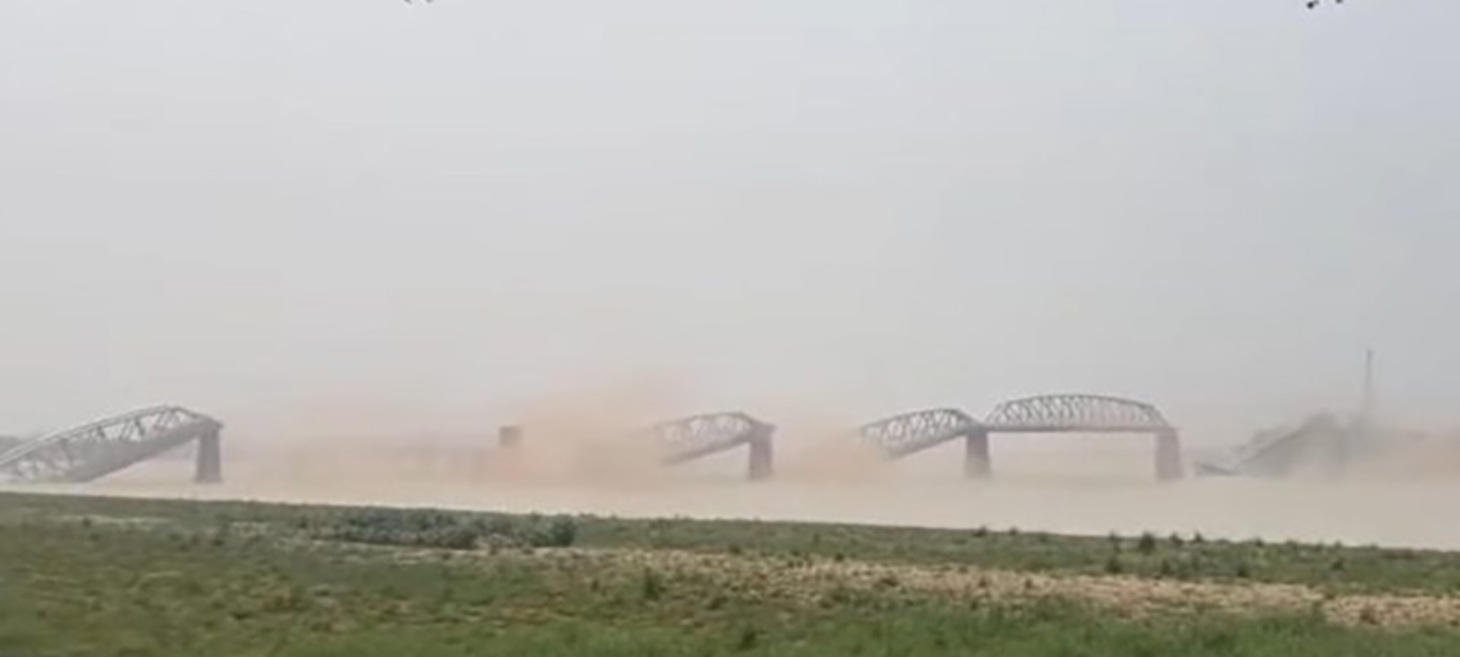
Colonial-era Ava Bridge over Irrawaddy River collapses during earthquake
The 91-year-old Ava Bridge, also known as the Old Sagaing Bridge, which was built by the British during the colonial period and spanned the Irrawaddy River between Mandalay and Sagaing regions, collapsed on Friday afternoon during a powerful 7.7-magnitude earthquake that affected both Myanmar and Thailand. The epicenter of this earthquake was near Sagaing town, and it caused the collapse of several buildings in Mandalay, Naypyitaw, and other areas.
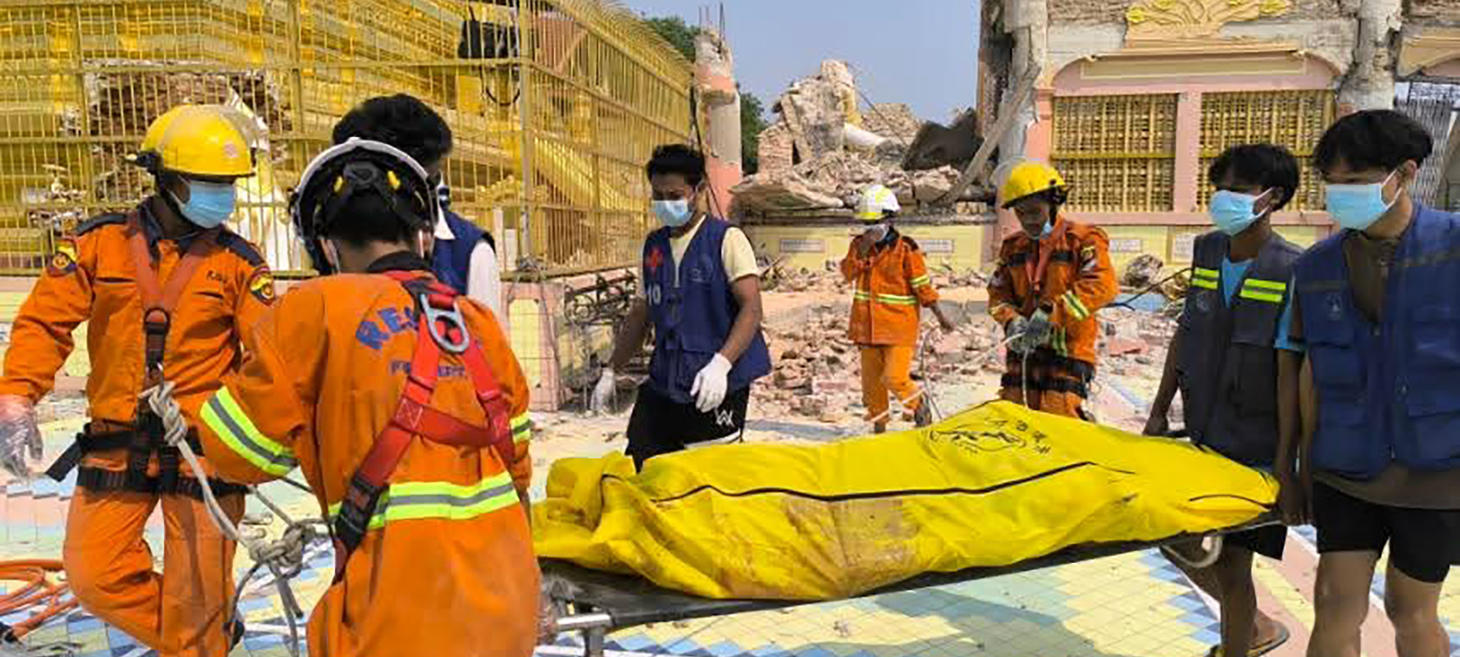
Rescue Efforts at Myanmar Earthquake’s Epicenter Hampered at Every Turn
Sagaing Township, the epicenter of a 7.7 earthquake, has suffered staggering devastation, with approximately 80 percent of the buildings in Sagaing city’s urban area reduced to rubble and a pervasive smell of decomposing bodies. Rescue efforts face enormous challenges due to a lack of specialized equipment and interference from the military and junta-aligned militia, who are obstructing aid from neighboring regions. Hundreds of deaths have been reported, with approximately 200 bodies recovered so far, including around 100 Muslim worshippers killed in mosque collapses and the principal and three students trapped at Myat Private High School. Dozens of children also remain trapped in the collapsed Lay Kyun Myay Oak Kyaung Monastery, and the official death toll of 1,700 is estimated by the U.S. Geological Survey to potentially reach 10,000. While survivors desperately need food, clean water, and medical supplies, Sagaing has received less aid than other affected regions, with a Malaysian team being the first international aid group to arrive.
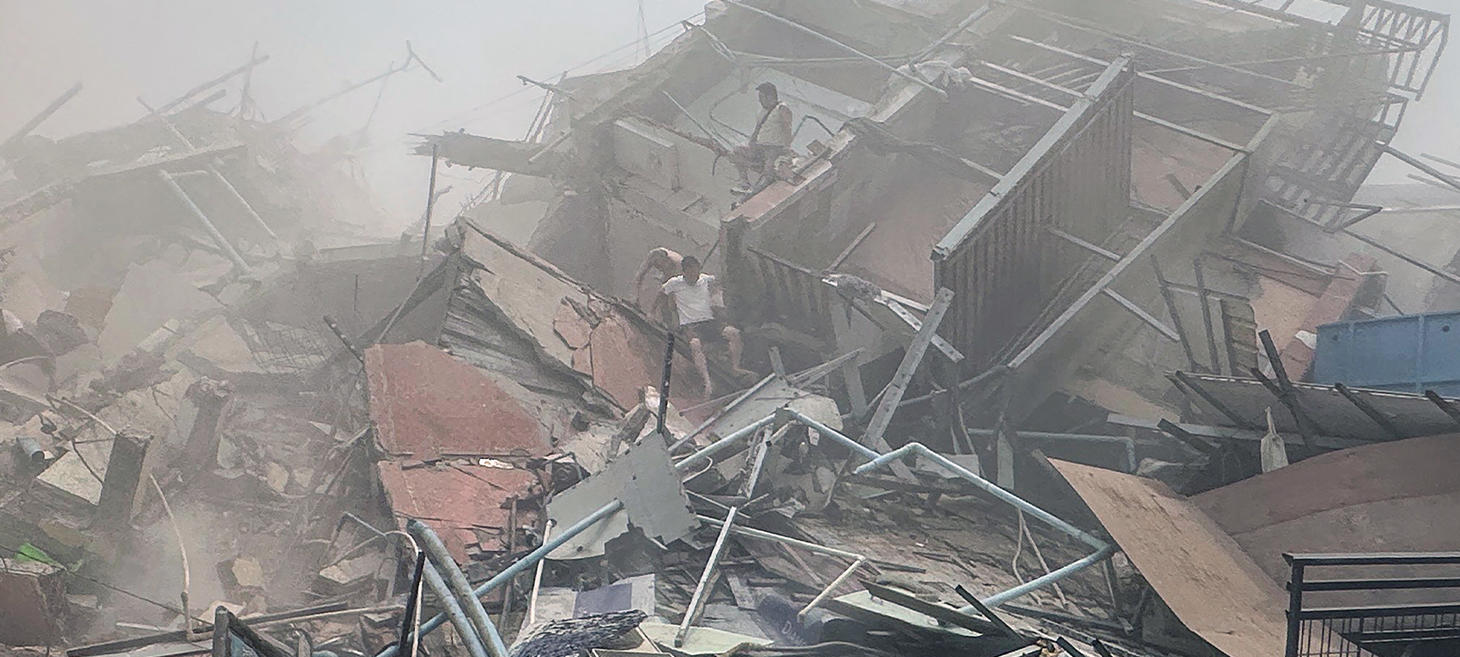
Deliver Earthquake Aid to the Myanmar People, Not the War Criminals
A 7.7-magnitude earthquake struck central Myanmar, already ravaged by civil war, a day after junta leader Min Aung Hlaing boasted of the military's strength. Despite his claims of prioritizing "national stability" through increased military spending, the regime was completely unprepared for the disaster, lacking any response plan or relief mechanisms, and having previously looted emergency funds. Following the earthquake, which caused over 1,000 deaths, Hlaing declared a state of emergency and appealed for international aid. However, this mirrored the junta's historical failures during crises like Cyclone Nargis and the COVID-19 pandemic, where they obstructed aid and prioritized other agendas. Concerns remain about the regime's ability and willingness to deliver aid effectively due to corruption and ongoing conflict, particularly in resistance strongholds, alongside their control over media and internet access which isolates affected populations. The international community has pledged support, but ensuring aid reaches those in need transparently through civil society groups, bypassing the junta, is crucial to support the people of Myanmar without legitimizing the military regime.

Soaring Death Toll Feared in Myanmar as Powerful Earthquakes Strike
Powerful earthquakes struck mainland Southeast Asia on Friday, March 28, 2025, with a magnitude 7.7 quake followed by a magnitude 6.4 quake near its epicenter in Myanmar's Sagaing region. The initial quake, with its epicenter 16 km north-northwest of Sagaing at a depth of 10 km, caused buildings to collapse in Myanmar and was felt as far away as Bangkok, Thailand, and in Vietnam, Bangladesh, India, Laos, and China. The USGS estimated a 35 percent likelihood of the death toll being between 1,000 and 10,000 and an equal probability of economic losses reaching $10 billion. In Myanmar, scores, perhaps hundreds, of buildings, including pagodas and mosques, collapsed, and the Mandalay International Airport reportedly suffered roof collapse. Bangkok declared an “emergency zone” after a skyscraper under construction collapsed, killing at least one person. Myanmar's junta leader declared a state of emergency in six regions and requested international humanitarian aid, while the ongoing civil war hampered information flow and relief efforts. The Mandalay-Sagaing area is part of the Alpide Belt and the Sagaing Fault, a region known for earthquakes. The devastating quake was the largest to hit central Myanmar since 1839.

Myanmar Earthquake Toll Rises Over 2,000 as Rescue Operations Continue
A 7.7 magnitude earthquake struck central Myanmar on March 28, 2025, resulting in a death toll that has topped 2,000, with over 2,056 deaths and 3,900 injuries reported by the military junta. The earthquake caused widespread destruction in Mandalay, Naypyidaw, Sagaing, Magwe, and Bago regions, along with areas in Shan State. The United Nations health agency warned that the disaster has overwhelmed the country’s poorly equipped healthcare system. Rescue operations are ongoing but face significant obstacles such as damaged roads, collapsed bridges, unstable communications, and civil conflict. The earthquake, which was the largest to hit central Myanmar since 1839, resulted from a grinding of the Sagaing Fault and was amplified by unconsolidated river sediments in the Irrawaddy valley. Many collapsed buildings were reportedly of brick, block, or ‘soft-story’ construction, which are prone to collapse. The Muslim communities of Mandalay and Sagaing regions appear to have been disproportionately affected, with over 60 mosques destroyed and an estimated 700 Muslim worshipers killed. The full extent of the damage remains unclear due to the contested political situation and internet shutdowns, with the US Geological Survey estimating a potential death toll between 10,000 and 100,000.
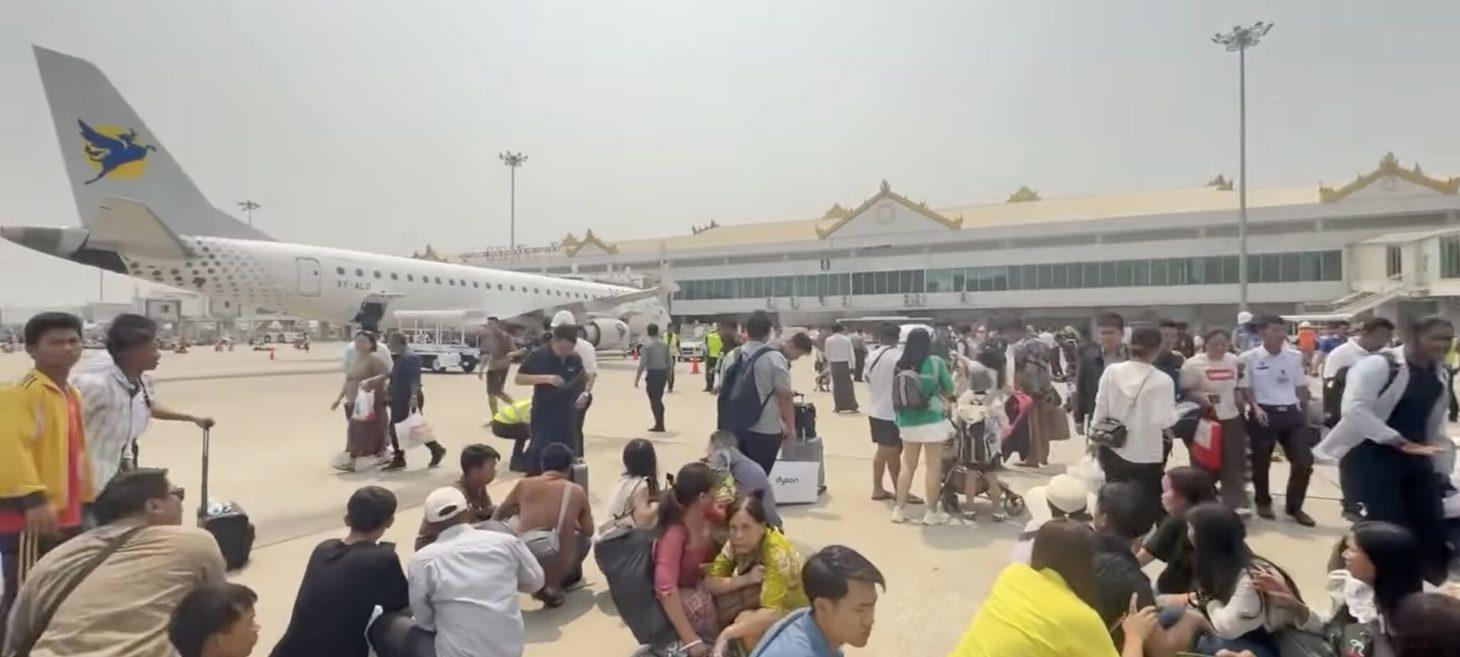
Collapse of control tower closes airport in Myanmar capital
A major 7.7-magnitude earthquake struck near Mandalay around noon on Friday, March 29, 2025, leading to the closure of the main airport in Myanmar’s capital, Naypyitaw, due to the collapse of its air traffic control tower, which resulted in at least six deaths. The earthquake also forced the closure of the Mandalay airport with reports of extensive damage to aviation equipment. Consequently, radar systems and radio equipment in both Naypyitaw and Mandalay are non-operational, leaving Yangon as the only operational airport in the country, handling relief flights. The disaster caused a significant death toll, with official figures reporting 808 fatalities, including 694 in Mandalay. The junta has requested international assistance to address the aftermath, while rights groups emphasize the need for aid to reach all affected areas.
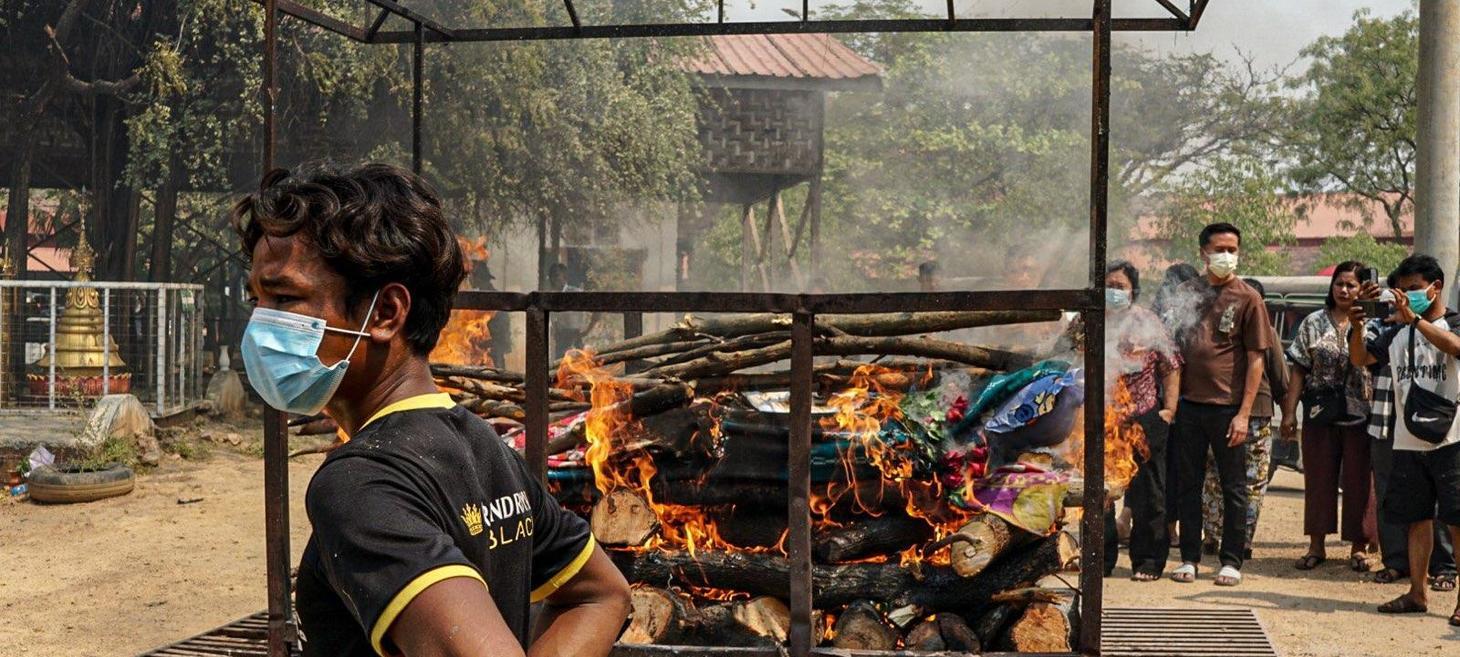
Junta blocks quake coverage as death toll jumps to 1,700
A 7.7-magnitude earthquake struck central Myanmar on March 28, 2025, causing widespread destruction in areas including Mandalay and Naypyitaw, and by Sunday afternoon, regime figures reported approximately 1,700 deaths and thousands injured and missing, though independent sources suggest these numbers could be significantly under-reported. The military junta has barred international journalists from accessing the devastated areas, citing a lack of essential services, which has raised concerns about an information blackout and the transparency of the regime's response to the growing humanitarian crisis. Despite restrictions and risks, independent media outlets like Myanmar Now continue to report on the disaster, while the international community increasingly demands unfettered access for aid workers and journalists.
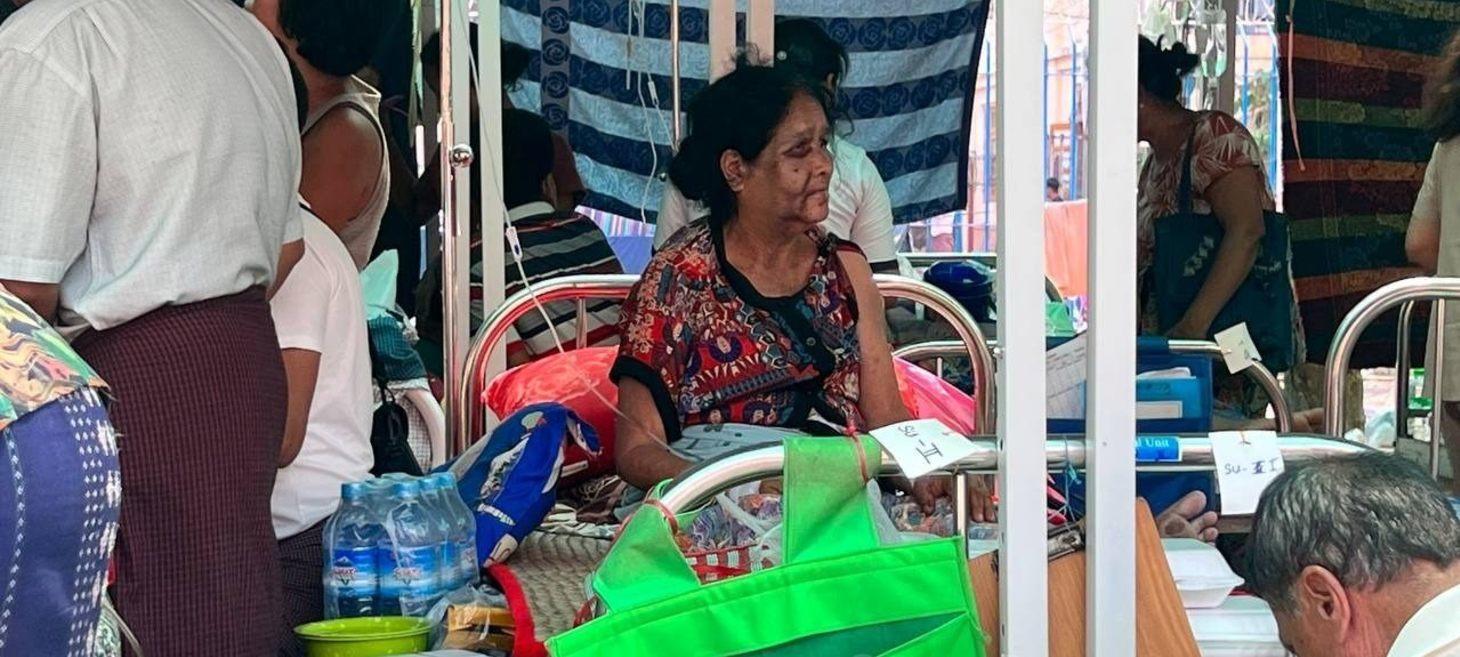
International aid flows to Myanmar after devastating quake
A devastating 7.7-magnitude earthquake struck central Myanmar on Friday, March 28, 2025, causing widespread destruction in cities like Mandalay, Sagaing, and Naypyitaw, leaving thousands dead and tens of thousands displaced. The United Nations and international aid organizations, along with foreign governments such as the UK, Australia, the US, China, India, Russia, and several Southeast Asian nations, are mobilizing to provide assistance in the form of funds, supplies, and personnel. However, significant concerns exist regarding the potential for the Myanmar junta to misdirect or impede the delivery of aid, possibly favoring areas under their control and restricting access to others, a pattern seen in past disasters like Cyclone Nargis. The earthquake has exacerbated existing humanitarian needs, including food insecurity and strained medical resources, while infrastructure damage further complicates rescue and aid efforts, and the junta has barred foreign journalists from reporting on the crisis.
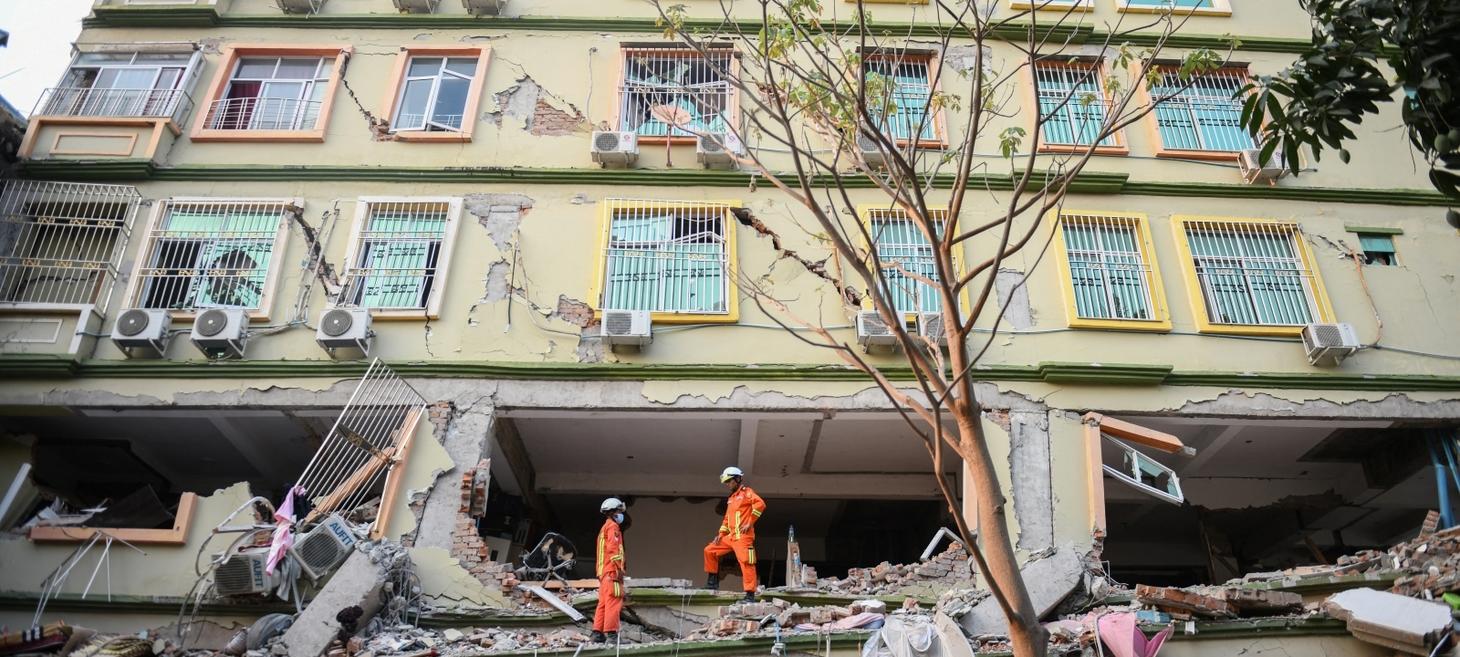
Rescue hopes fading three days after deadly Myanmar quake
A massive 7.7-magnitude earthquake struck near Mandalay, Myanmar, on Friday, March 28, 2025, followed by a 6.7-magnitude aftershock, causing widespread destruction including collapsed buildings, downed bridges, and buckled roads in central Myanmar. The earthquake killed at least 1,700 people in Myanmar and neighboring Thailand. Rescue efforts in Mandalay, a city of over 1.7 million people, faced challenges due to the sticky heat, which exhausted workers and accelerated body decomposition. Hopes of finding more survivors faded after three days, exemplified by the tragic death of a pregnant woman rescued from rubble after 55 hours. Aftershocks caused panic among residents, while the International Federation of Red Cross and Red Crescent Societies launched an emergency appeal for over US$100 million. In Bangkok, about 1,000 kilometers away, a building under construction collapsed due to the quake, resulting in at least 18 deaths and many missing. The disaster struck Myanmar, already struggling with four years of civil war and 3.5 million displaced people.
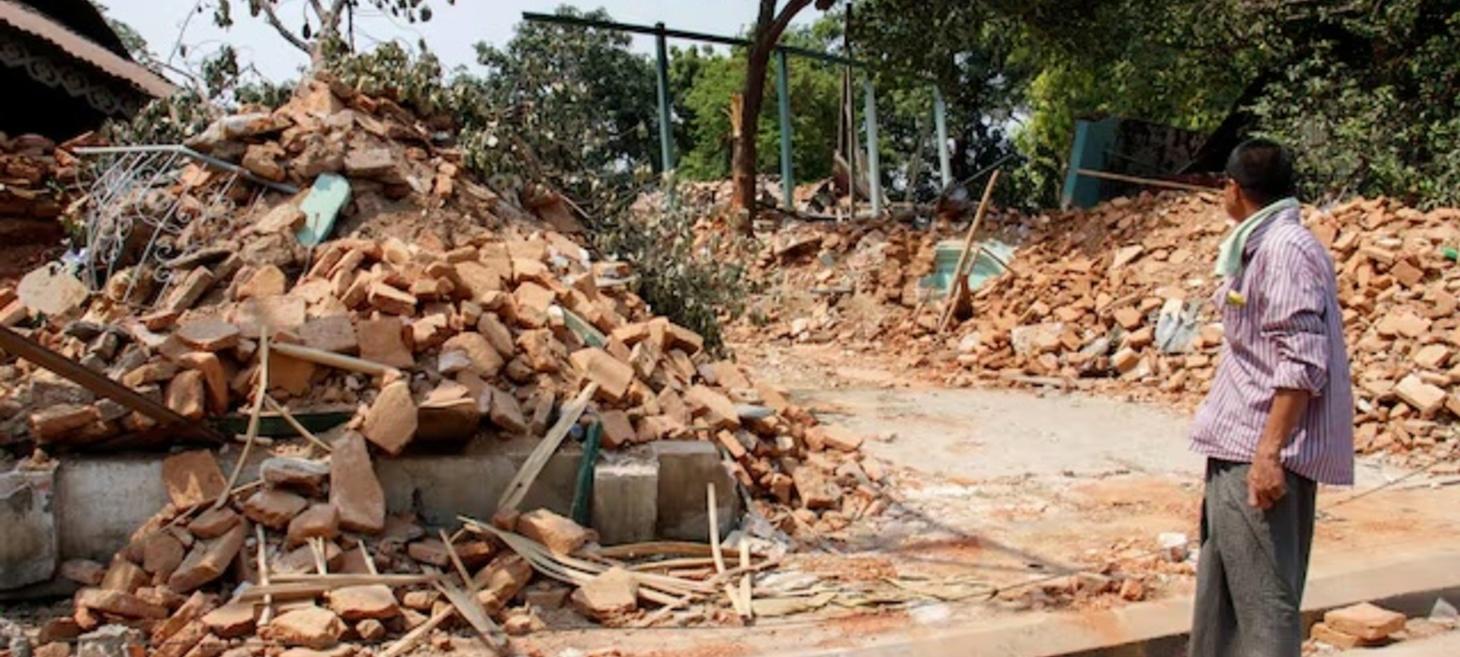
US State Dept: USAID team of experts traveling to Myanmar post-quake
Following a devastating earthquake in Myanmar that killed over 2,000 people, the U.S. State Department announced that a USAID assessment team was being sent to identify the country's needs. However, the team's departure was reportedly delayed due to visa issues with Myanmar's military rulers. Moreover, the overall U.S. response has been hindered by significant fund cuts, contractor terminations, and plans to fire nearly all USAID staff directed by the Department of Government Efficiency (DOGE) under Elon Musk, which began earlier with President Trump's aim to merge USAID into the State Department aligning with his "America First" policies. This has led to "internal confusion," a lack of "surge capacity," and delays in deploying personnel and supplies, despite a formal request for help from Myanmar and a pledge of $2 million in aid. Critics suggest that these DOGE cuts and administrative changes have severely impeded what would have been a rapid U.S. emergency response, contrasting with the swift assistance offered by countries like China and Russia.
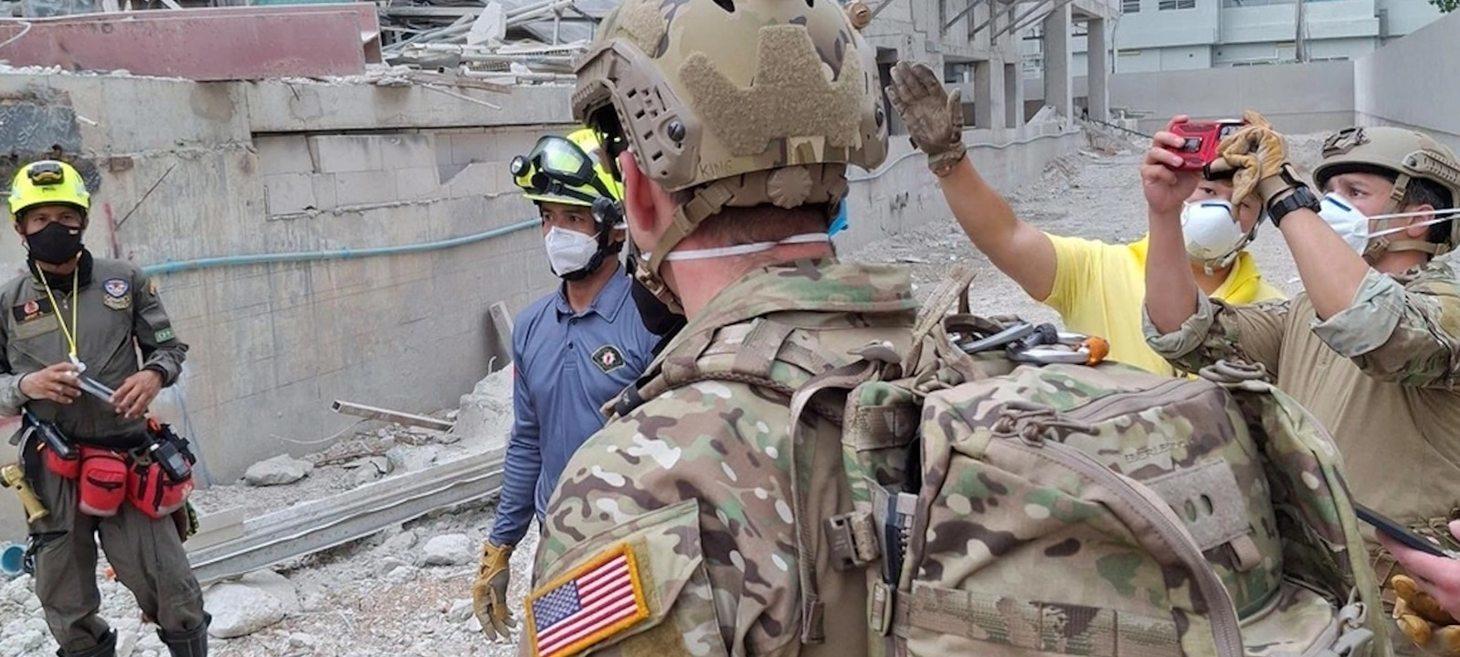
US pledges $2 million for Myanmar quake, but China already filled the void
Following a devastating 7.7 magnitude earthquake in Southeast Asia, which killed over 2,000 people in Myanmar and caused a building collapse in Bangkok, Thailand, the US pledged $2 million in aid and deployed a small USAID emergency response team to assess the situation in Myanmar, although they had not yet entered the country as of Monday morning. This response is occurring amid President Trump's efforts to dismantle USAID, which the State Department acknowledges has caused some logistical impact despite their assertion that funding is not the primary limitation. In contrast, China arrived 18 hours after the quake, has over 400 personnel on the ground, and has provided $14 million in aid, which is seen as a propaganda win for Beijing, demonstrating its reliability as a partner in crisis. While a US team of experts is heading to Myanmar, and US military personnel are working with Thai military and Israeli soldiers in Bangkok, the pace of the initial US response appears slower compared to past disasters, and discussions are ongoing regarding a potentially smaller Disaster Assistance Response Team deployment.
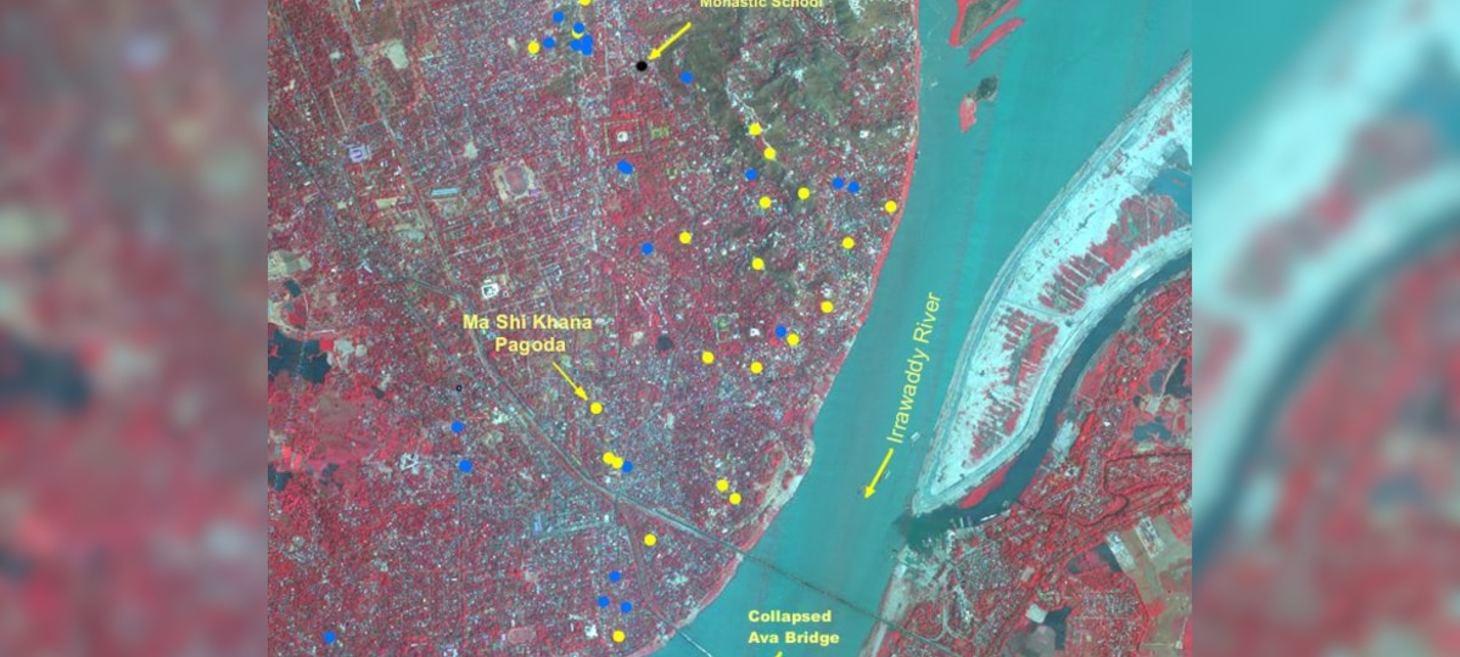
ISRO Satellite Images Show Damage After Earthquake Rattled Myanmar
A 7.7 magnitude earthquake struck Myanmar on Friday, followed by a 6.4 magnitude aftershock, with the epicentre near the Sagaing-Mandalay border. The Indian Space Research Organisation (ISRO) released satellite images captured by its Cartosat-3 satellite, revealing widespread damage in Mandalay and Sagaing cities, including the collapse of a major bridge over the Irrawaddy River (the historic Ava (InnWa) Bridge), damage to Mandalay University and the Ananda Pagoda, as well as other significant landmarks like Sky Villa, Phayani Pagoda, and Mahamuni Pagoda. The earthquake, likely caused by the release of stress along the Sagaing fault or its accessory faults near the convergent boundary of the Indian and Eurasian plates, also caused damage to infrastructure, roads, and residential buildings in Naypyidaw and was felt in neighboring countries, including Thailand. ISRO utilized Cartosat-3 imagery acquired post-disaster on Saturday and compared it with data from March 18 to assess the damage, observing cracks in flood plains and liquefaction along the Irrawaddy River. India was among the first to offer assistance to Myanmar.

Press Statement: Civil society calls for disaster relief for earthquake survivors and affected communities in Myanmar
Following a severe earthquake in Myanmar and Thailand on March 28, 2025, a coalition of 265 Myanmar, regional, and international civil society organizations is urgently calling for immediate disaster relief to be channeled to survivors and affected communities in Myanmar. They emphasize that aid must be directed through local community groups, frontline responders, the National Unity Government (NUG), and Ethnic Resistance Organizations (EROs), warning against the military junta exploiting, manipulating, or weaponizing aid for its political and military gain, citing the junta's history of obstructing and misusing aid, as exemplified by Cyclone Nargis in 2008. The organizations welcome the NUG's pause in offensive operations and urge the international community, including the UN and ASEAN, to collaborate with legitimate stakeholders and utilize border-based channels to ensure aid reaches those in need without junta interference, adhering to humanitarian principles.
Politics
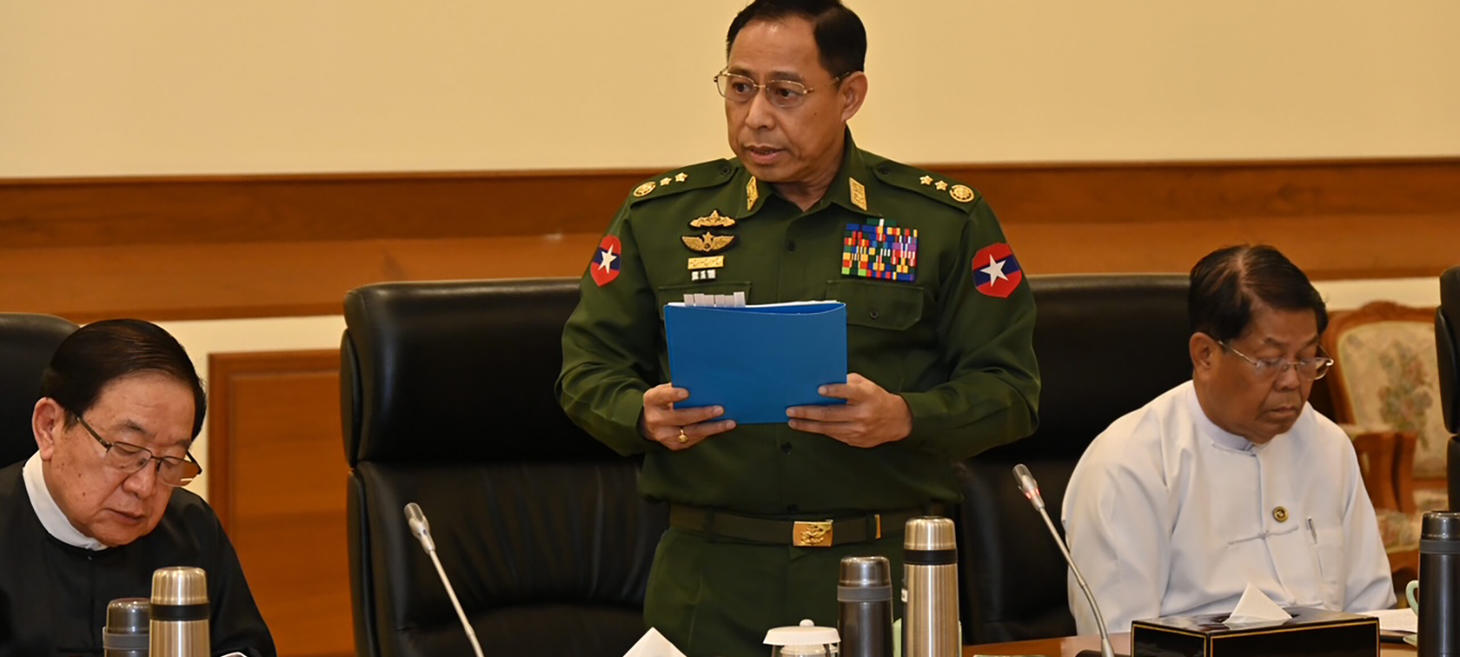
Myanmar General Dismisses Any Retreat From Politics
The Myanmar junta's border security minister, Lieutenant General Yar Pyae, stated during the "Peace Talks 2025" in Naypyitaw that the military withdrawing from politics was an "impossible request". He also mentioned that the junta had no preconditions for discussions, while some groups demanded the military's exit from politics, its disbandment, and the formation of a transitional government, deeming these demands unrealistic. Despite ongoing conflicts and the major anti-regime forces, including the National Unity Government, stating they would only negotiate if the junta stopped killing civilians and quit politics, the junta claimed to be open to discussions without preconditions and announced further peace talks. Junta chief Min Aung Hlaing announced an election would be held in late December 2025 or early January 2026, with efforts being made for a "free and fair" process and invitations to external observers. Veteran activist U Ko Ko Gyi, who has registered his People’s Party to contest the election, stated that the election result could not directly challenge the military's rule and that resolving the ongoing civil war requires cooperation with the military.
Telecommunications
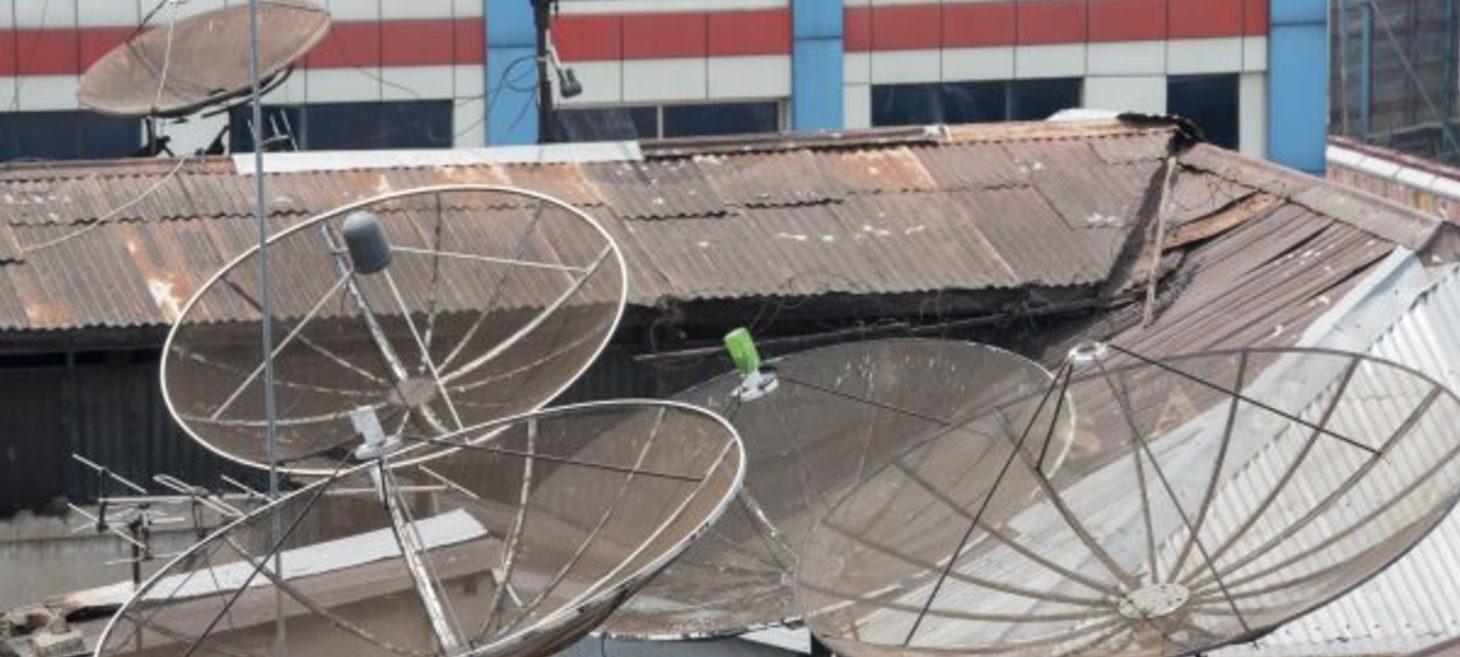
Myanmar’s Military Is Tightening Its Grip on Cyberspace
Myanmar's military junta in its fifth year of rule is increasingly tightening its grip on the country's cyberspace, as highlighted by three major recent developments. Firstly, Myanmar has witnessed an alarming surge in cybercrime, including online scams, fueled by the pandemic and the 2021 coup, and enhanced by technologies like deepfakes and AI. Secondly, the junta enacted a Cybersecurity Law in January 2025, imposing licensing for digital platforms, regulating information, and restricting VPN services, reflecting a priority on controlling information over combating cybercrime. Thirdly, the junta is reinforcing cyber sovereignty through closer ties with Russia and China, adopting their technological and ideological frameworks on information security and internet governance, which has strengthened the junta's digital surveillance capabilities. These efforts, coupled with the junta's focus on control ahead of planned elections, pose a significant threat to digital freedom in Myanmar.

Facebook’s ‘lethal carelessness’ in Myanmar
A former Facebook director of public policy, Sarah Wynn-Williams, alleges in her book Careless People that Facebook's management was "deeply unconcerned" about its role in Myanmar, leading to "lethal carelessness" and potentially "gross negligence" in protecting users, particularly amid the Rohingya crisis. Facebook achieved dominance in Myanmar, becoming synonymous with the internet due to aggressive expansion and free data offers, but it failed to implement meaningful safeguards against misinformation or understand the local political and social landscape. This allowed malign actors, including the military, to spread hate speech and disinformation, which Wynn-Williams describes as the "worst" globally. Despite internal and external warnings, Facebook's moderation was deeply flawed due to language barriers, lack of prioritization of Myanmar, and a slow response to problematic content, including a racial slur against the Rohingya. Wynn-Williams concludes that Myanmar would have been better off without Facebook, highlighting the company's role in enabling violence through its platform and its "blindly unconcerned" senior management, although Meta claims to have learned from these past mistakes.